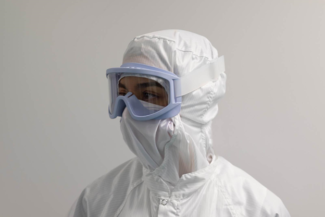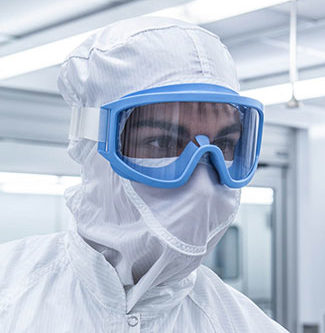Eye Protection Safety Guide for Cleanrooms

Cleanroom goggles not only protect workers from various substances. They can also help keep cleanrooms sterile. Yet, among many different industries, about 2,000 U.S. workers sustain an eye injury at work, according to the Centers for Disease Control and Prevention (CDC).1 Most of these injuries can be avoided with eye protection.
How Goggles Prevent Cleanroom Contamination
Cleanroom personnel often unintentionally bring contamination into sterile environments. While it’s difficult to be 100% contamination-free, cleanroom safety goggles can help limit some types of contamination. Of the normal microflora identified in cleanrooms, 80% to 90% can be attributed to humans.2
Viruses, bacteria, and skin particles can easily affect a cleanroom environment. Every time we blink, our eyes produce mucus. Eye shadow, eyebrow pencil, and other cosmetics can release particulates or can outgas, which can be detrimental to a sterile room. However, particles can adhere to goggles, too, which is why they should be cleaned before entering any cleanroom.
How Goggles Protect Your Eyes in the Cleanroom
The American National Standards Institute’s Z87.1-2010 standard sets the requirements for safety eyewear. Lens thickness, light transmittance, and impact resistance are just some qualities it has stringent requirements for. Plus, the eye protection used must match the specific hazard a worker is exposed to. Polycarbonate is a common material because it is resistant to impacts, is flexible, and offers protection against ultraviolet light. The same material is used for bulletproof windows.
Some of the hazards that cleanroom goggles can protect your eyes from include:
- Harmful chemicals and other corrosive compounds
- Intense light sources such as lasers, UV lamps, welding sources, and heat-treating equipment
- Various forms of optical radiation
- Liquid solutions that can cause eye damage
- Biological samples
- Electrical hazards, such as arc flashes
- High temperatures
- Dust and other fine particles
- Radioactive materials

In many cleanrooms, intense lights are used, and workers must be in close proximity to mirrored surfaces. Polarized safety goggles should be worn in these cases, but other precautions to be executed include:
- Use of prescription eyewear: The goggles should either incorporate vision prescriptions into their design or be made to be worn over prescription lenses.
- Comfort/fit: Eye protection must fit snuggly and be properly sized for the individual wearing it. Specific brands and styles may need to be considered, while straps and other adjustable fitting features are important.
- Specialty eye protection: Specially designed cleanroom safety goggles include those designed for use around lasers (Class 3 or 4), UV light, welding, and equipment and machinery that can cause impact-related injuries.
Order PPE from Prudential Overall Supply’s Cleanroom Services
Our business specializes in reusable cleanroom goggles, masks, and gloves, as well as sanitizers, mats, towels, and cleaning supplies and solutions for various industries. Our SAL 10-6 validated sterile reusable goggle program ensures products that last longer with zero degradation. Call 800-767-5536 to learn more.
Source: